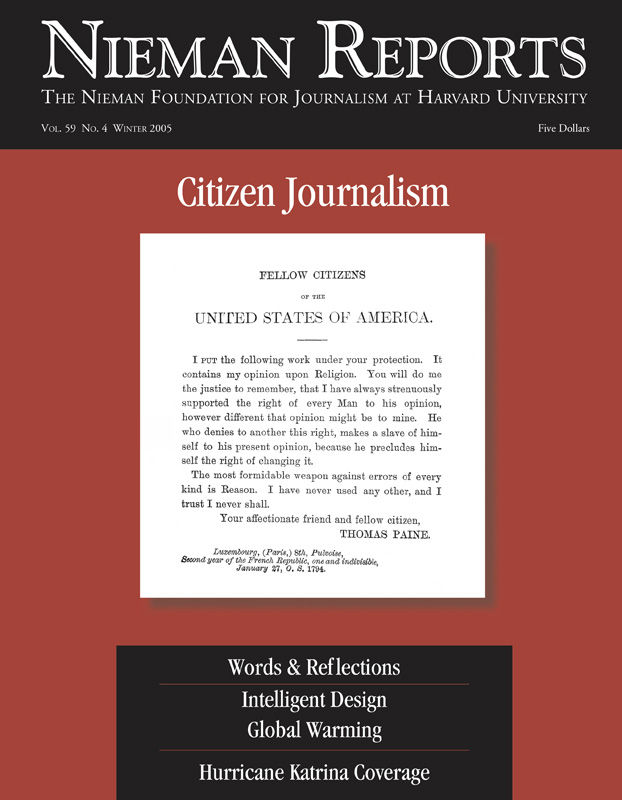“Let me begin with a confession. After watching television coverage of Katrina for nearly every wakeful moment over the first few dramatic days, I quit. Cold turkey,” writes Curtis Wilkie, who holds the Cook Chair in Journalism at the University of Mississippi, after a lengthy reporting career at The Boston Globe that included being a correspondent in New Orleans, where his home is located. “TV news had morphed into a mutant reality show: ‘Survivor’ gone berserk.” With those words, Wilkie opens our collection of reflective essays written in the aftermath of Hurricane Katrina by journalists who either went to the devastated region to report or grew up in a place the floodwaters destroyed.
Will Sutton, the Scripps Howard Visiting Professional at the Scripps Howard School of Journalism and Communications at Hampton University, grew up in the Lower Ninth Ward of New Orleans and recalls a vibrant neighborhood routinely ignored by local and national media. “As we look for what ‘sells,’ improving the human condition doesn’t sell as well as news where there is clear conflict … news where more affluent people are affected,” he writes, and explains why the press should pay attention now.
Carolyn Cole, a photojournalist with the Los Angeles Times, shares words and images about her experiences in New Orleans, and her photographs also accompany a poignant account by Los Angeles Times correspondent Elizabeth Mehren of the human misery and resilience her stories portrayed. Mehren writes, “It is impossible to exaggerate the devastation I encountered in 10 days on the Mississippi Gulf Coast immediately after Hurricane Katrina.”
Boston Globe reporter Kevin Cullen writes about the reporting of rumors and how race played out in the coverage of Katrina: “Class and race are inextricably bound up in New Orleans, and trying to make sense of it was as hard as trying to get accurate information.” From Southeast Asia, freelance journalist Philip J. Cunningham shares observations about reporters’ frequent use of the words “Third World” in their hurricane coverage. And Nuri Vallbona, photojournalist with The Miami Herald, describes photographing Katrina’s destruction from a plane, then later at ground level. “… each bank of the chopper revealed more devastation, more than I’d seen in my career as a photojournalist,” she writes.
The (New Orleans) Times-Picayune cartoonist, Steve Kelley, explains what it was like to create cartoons about Katrina’s aftermath when he was stuck thousands of miles away, unable to get back home. “People would ask how I could draw cartoons about a story from so far away. The answer is that political cartoonists … don’t report the news, we tailgate it,” he writes. And Mary C. Curtis, executive features editor and columnist at The Charlotte (N.C.) Observer, offers journalists some questions to think about in the aftermath of what Katrina revealed about poverty and race, as she wonders whether “this catastrophe will affect the topics that journalists decide to cover and how they practice their craft.”
Will Sutton, the Scripps Howard Visiting Professional at the Scripps Howard School of Journalism and Communications at Hampton University, grew up in the Lower Ninth Ward of New Orleans and recalls a vibrant neighborhood routinely ignored by local and national media. “As we look for what ‘sells,’ improving the human condition doesn’t sell as well as news where there is clear conflict … news where more affluent people are affected,” he writes, and explains why the press should pay attention now.
Carolyn Cole, a photojournalist with the Los Angeles Times, shares words and images about her experiences in New Orleans, and her photographs also accompany a poignant account by Los Angeles Times correspondent Elizabeth Mehren of the human misery and resilience her stories portrayed. Mehren writes, “It is impossible to exaggerate the devastation I encountered in 10 days on the Mississippi Gulf Coast immediately after Hurricane Katrina.”
Boston Globe reporter Kevin Cullen writes about the reporting of rumors and how race played out in the coverage of Katrina: “Class and race are inextricably bound up in New Orleans, and trying to make sense of it was as hard as trying to get accurate information.” From Southeast Asia, freelance journalist Philip J. Cunningham shares observations about reporters’ frequent use of the words “Third World” in their hurricane coverage. And Nuri Vallbona, photojournalist with The Miami Herald, describes photographing Katrina’s destruction from a plane, then later at ground level. “… each bank of the chopper revealed more devastation, more than I’d seen in my career as a photojournalist,” she writes.
The (New Orleans) Times-Picayune cartoonist, Steve Kelley, explains what it was like to create cartoons about Katrina’s aftermath when he was stuck thousands of miles away, unable to get back home. “People would ask how I could draw cartoons about a story from so far away. The answer is that political cartoonists … don’t report the news, we tailgate it,” he writes. And Mary C. Curtis, executive features editor and columnist at The Charlotte (N.C.) Observer, offers journalists some questions to think about in the aftermath of what Katrina revealed about poverty and race, as she wonders whether “this catastrophe will affect the topics that journalists decide to cover and how they practice their craft.”



